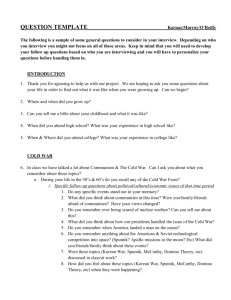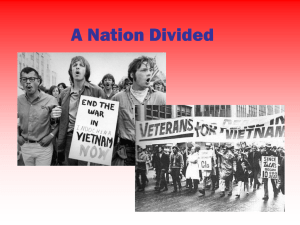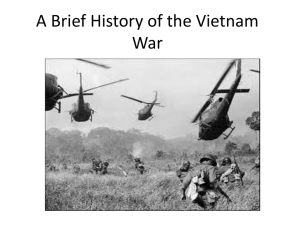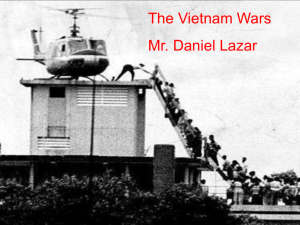Slides
advertisement
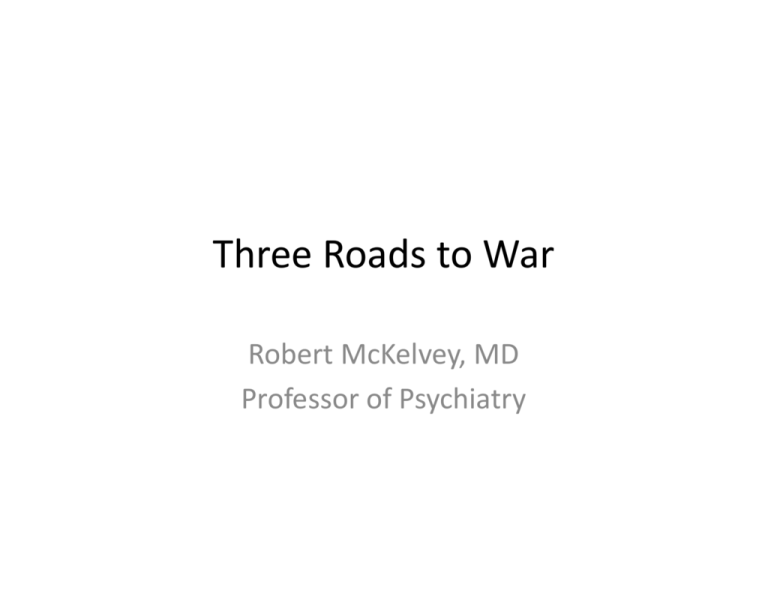
Three Roads to War Robert McKelvey, MD Professor of Psychiatry Truong Nhu Tang Dang Thuy Tram Robert McKelvey Nguyen Ai Quoc with Trotsky US Foreign Policy toward Vietnam 1954‐1968 • Dominated by a set of beliefs based on: – Recent historical events – Concept of US role in the world First Core Belief • Monolithic, aggressive, advancing Communism focused on world domination – “Loss” of China in 1949 – Iron Curtain – Chinese intervention in Korean War The “Red Scare” • Senator Joseph McCarthy – “card carrying Communists” in many areas of US life – “in this briefcase… • Colonial and nationalistic movements misinterpreted as advancing Communism – Indonesia, Laos, Malaysia, Vietnam US Response in Vietnam • Linking itself to governments with little popular support, but… • “Anti‐communist” • Attempt to build an independent, non‐ Communist Vietnam • Unable to find a leader able to unite the South against North Vietnam or the National Liberation Front Second Core Belief • The Domino Theory • If Communist aggression unchecked, the successive collapse of vulnerable regimes • Fighting the Communists “on the beaches of California” • Must “contain” Communism wherever found Fears of “Appeasement” • 1938 – Chamberlain and Hitler • Munich Agreement led, not to “peace in our time,” but to further German aggression Third Core Belief • American “credibility” must be maintained • US could not be seen as a “paper tiger” • US retreat would tell Communists we would not stand by our commitments • What would happen to Japan, South Korea, and West Germany if US could not be relied upon? Vietnam as Test Case for Core Beliefs • Symbol of US standing by its commitments • An “Asian Berlin” • Proving ground for – US policies of “nation building” – Use of counterinsurgency forces (the Green Berets) to combat wars of “national liberation” as espoused by Mao Zedong No US President wanted to be the first to Lose a Foreign War • Kennedy, Johnson, Nixon haunted by memories of the McCarthy era • Political consequences of appearing weak against Communism Initial Attempts • Military advisors, financial aid, covert CIA action used to support Ngo Dinh Diem • Diem a strong, but autocratic leader • Exercised power through his family (Madame Nhu – “the dragon lady”) and confederates • Many enemies • Unable to win support of countryside The US Takes Over • Diem assassinated • Followed by a series of weak leaders • Johnson administration decided US must take the lead or South Vietnam would be lost • At its peak, US commitment of over 500,000 troops and massive airpower against the North and South Johnson’s “Duplicity” • LBJ wanted to protect “Great Society” program • Never formally declared war • Instead, used the “Tonkin Gulf Resolution” • Never fully informed Congress or US people of what was being done in Vietnam • Led to a massive “credibility gap” US Policy in Vietnam • Apply massive military force • Create the security necessary for pacification • “Win the hearts and minds” of the South and drive the North to negotiate • Unfortunately, massive bombing of the North and huge “body counts” did not drive the North to sue for peace Military Views of the Conflict • “If you grab them by the balls, their hearts and minds will follow.” • “War is our business and business is good” • “It’s the only war we’ve got” Failure of US Policy • North Vietnam could replace its forces and supplies regardless of US bombing • Tet Offensive of 1968 proved to US public that the war could not be won • Sadly, five more years of war were needed to end US involvement


